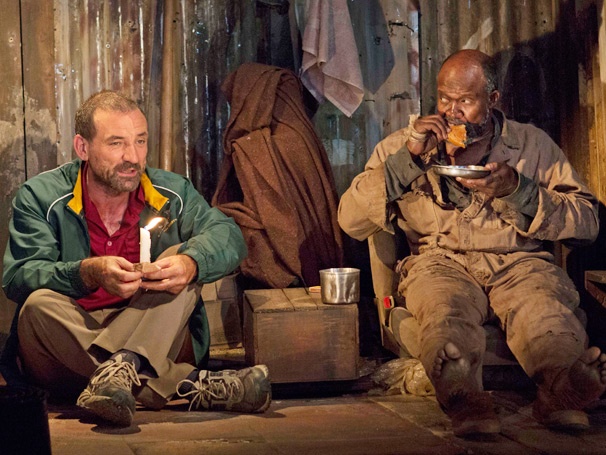Fugard’s The Train Driver is a performance made unique and memorable by the way it was told. Its uniqueness lies in the fact that this is a two person play that creatively makes use of the power of memory through story telling. The plot is driven through listening to Roelf (Ritchie Coster) tell his story. But the play becomes mind-blowing when one realizes that this is actually a story within a story since the play is in actuality a memory being told to us by Simon (Leon Addison Brown). Even if the play tanks, Fugard deserves credit for the ingenius way the play is presented. The plays meta qualities show how memory is a central theme this play.

Credits to Richard Termine/Boneau/Bryan-Brown via Bloomberg
Ritchie Coster and Leon Addison Brown made no noticeable mistakes in their lines. Coster portrays his character well but he does not come without a few grievances. He is able to effectively deliver the raw rage and desparation that initially consumes his character Roelf. Although his accent is initially thick and rough, his tone of voice is more than enough to adequately show his frustration. Once I was adjusted to his thick accent, the myriad of profanity spewed constantly from his mouth. At first what seemed like disgruntlement quickly became repetitive almost to a point where it plain vulgar.
Leon Addison Brown’s role as Simon is largely overshadowed by Coster’s role as Roelf. His humbleness, soft-spoken lines make him easily forgettable. However, this is not to say that he is unnecessary. His gentleness and innocent nature makes him incredibly likeable and is essential in Roelf’s mental transformation. Simon’s laid back attitude at times also provided tidbits of humor and comic relief that was necessary after tense moments filled with intense emotion.
The two demonstrated good teamwork in this two-man ninety production. There was no clashing between the actors. However, that is not necessarily a good thing. Without any big clashes between the characters, at times it was almost as if Brown’s character was part of the audience watching Coster play Roelf.
The setting was almost a whole achievement in itself. The broken down car, junk, litter, and sand scattered all over the place created a wonderful set that was pleasing to the eye and set aside the tradition wooden stages. Perhaps one of the most amazing things about the set was that there was interaction with the junk scattered around. The setting also effectively paralleled the desparation in Roelf. Here we see a man who is angry and largely confused wandering desperately in search of answers. Yet he ends up in a desolate and depressing graveyard. Who can answer his questions when everyone is dead here?

Credit to Signature Theatre
The play went undisturbed and flowed nicely. This was largely due to both the lighting and sound effects. The lights subtly changes from dark to bright and then back to dark to mimic the sun passing throughout the day. It happens a few times throughout the play. The sound effects also secretly combine with the lighting by creating sounds of wind to show the cool air of the night. What was amazing was that during the transition to night, waves of cool air actually passed through the theatre to convey a realistic feeling.
As a play with a social theme, The Train Driver does indeed show the results and aspects of apartheid in South Africa. Its ending offers a wake-up call with shocking realism about the fragility of life and how in the end we’re all just skin and bones.

